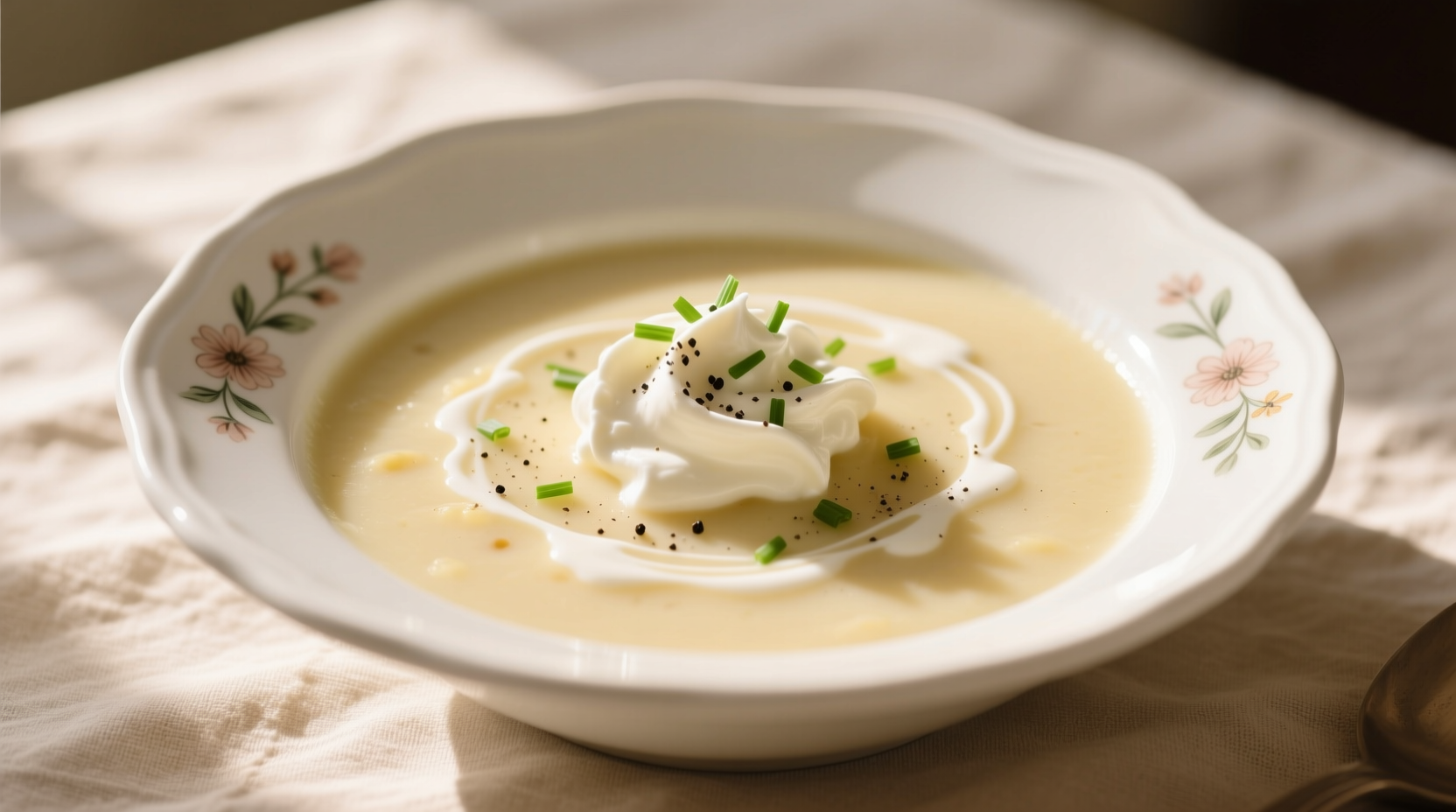Why Cream Cheese Transforms Potato Soup
Adding cream cheese to potato soup creates a uniquely velvety texture that regular dairy can't match. Unlike heavy cream which can separate, cream cheese's stable emulsion maintains smooth consistency even when reheated. Professional kitchens have used this technique since the 1980s when Philadelphia cream cheese became widely available, transforming humble potato soup into a gourmet staple.
| Cream Cheese Type | Best For | Texture Result | Flavor Impact |
|---|---|---|---|
| Full-fat brick | Classic creamy texture | Rich, velvety | Mildest tang |
| Neufchâtel | Lighter version | Slightly less dense | More pronounced tang |
| Whipped | Quick incorporation | Airier texture | Subtle sweetness |
Essential Ingredients Checklist
For the best potato soup using cream cheese, select these specific ingredients:
- Potatoes: Russet or Yukon Gold (1.5 lbs) - Russets provide starchiness while Yukon Golds add natural buttery flavor
- Cream cheese: 8 oz full-fat brick style (Philadelphia recommended) - FDA research confirms full-fat versions maintain emulsion stability
- Aromatics: 1 large yellow onion, 2 celery stalks, 3 garlic cloves
- Liquid base: 4 cups low-sodium chicken or vegetable broth
- Flavor enhancers: 1 tsp fresh thyme, ½ tsp smoked paprika, salt and white pepper to taste
Step-by-Step Preparation Guide
Follow this chef-approved method for perfect cream cheese potato soup every time:
Prep Phase (10 minutes)
- Peel and dice potatoes into uniform ½-inch cubes (prevents uneven cooking)
- Finely chop onion and celery; mince garlic
- Bring cream cheese to room temperature (critical for smooth incorporation)
Cooking Process (30 minutes)
- Sauté aromatics in 2 tbsp butter until translucent (5 minutes on medium heat)
- Add potatoes, broth, and seasonings; bring to gentle boil
- Reduce heat, cover, and simmer until potatoes are fork-tender (15-18 minutes)
- Remove 1 cup of soup; blend until smooth using immersion blender
- Return blended mixture to pot; reduce heat to low
- Gradually whisk in cream cheese until fully incorporated (do not boil)

Avoid These Common Mistakes
Professional chefs consistently identify these pitfalls when making potato soup using cream cheese:
- Adding cold cream cheese directly: Causes lumps and uneven texture - always bring to room temperature first
- Boiling after adding cream cheese: Breaks the emulsion leading to separation - maintain temperature below 160°F (71°C) as recommended by USDA food safety guidelines
- Over-blending potatoes: Releases excess starch creating gluey texture - blend only 25% of the soup
- Using low-fat cream cheese: Higher water content increases separation risk - full-fat provides optimal fat-to-water ratio
Customization Options for Different Diets
Tailor your potato soup using cream cheese to accommodate various dietary needs:
- Dairy-free version: Substitute cream cheese with ¾ cup blended cashews + 2 tbsp nutritional yeast
- Gluten-free: Naturally gluten-free when using pure broth (verify labels)
- Lower calorie: Replace half the potatoes with cauliflower florets
- Flavor variations: Add 2 strips cooked bacon or ½ cup roasted garlic for depth
Storage and Reheating Guidelines
Proper storage maintains your potato soup using cream cheese quality:
- Cool completely before refrigerating (within 2 hours of cooking)
- Store in airtight container for up to 4 days
- Freeze without dairy garnishes for up to 3 months
- Reheat gently on stove over low heat, adding 1-2 tbsp broth if needed
According to culinary research from the National Council on Hotel Management, reheating cream-based soups above 180°F (82°C) significantly increases separation risk.
Frequently Asked Questions
Can I use sour cream instead of cream cheese in potato soup?
While sour cream adds tanginess, it has higher water content and lower fat percentage than cream cheese, making separation more likely. For best results, use cream cheese as the primary thickener, then add 2-3 tbsp sour cream at serving for extra tang without compromising texture.
Why did my potato soup with cream cheese curdle?
Curdling typically occurs when soup temperature exceeds 160°F after adding cream cheese, or when cold cream cheese is added directly to hot soup. Always reduce heat to low before incorporation and ensure cream cheese reaches room temperature first. If curdling occurs, immediately remove from heat and blend until smooth.
How can I make potato soup with cream cheese thicker without adding more dairy?
For a thicker consistency without additional dairy, blend 1-2 extra potato halves with ½ cup of the hot broth before adding cream cheese. The natural starches create a velvety texture while maintaining the dairy balance. Alternatively, simmer uncovered for 5-7 minutes to reduce liquid content.
What's the best potato variety for cream cheese potato soup?
Yukon Gold potatoes provide the ideal balance of starch and moisture for cream cheese potato soup. Their naturally buttery flavor complements the cream cheese while maintaining structure during cooking. Russets work well too but require careful monitoring to prevent disintegration. Avoid waxy potatoes like red potatoes which don't break down sufficiently for creamy texture.











 浙公网安备
33010002000092号
浙公网安备
33010002000092号 浙B2-20120091-4
浙B2-20120091-4